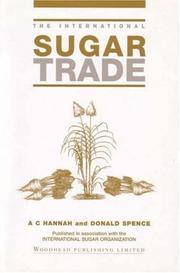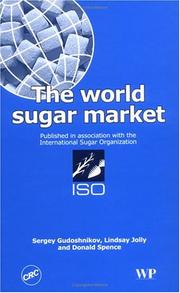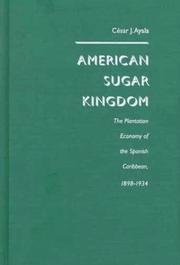| Listing 1 - 10 of 49 | << page >> |
Sort by
|

ISBN: 9781845699192 184569919X 1855730693 9781855730694 Year: 1996 Publisher: Abingdon, [England] ; Cambridge, [England] : Woodhead Publishing Limited,
Abstract | Keywords | Export | Availability | Bookmark
 Loading...
Loading...Choose an application
- Reference Manager
- EndNote
- RefWorks (Direct export to RefWorks)
This is the first book to cover in a comprehensive way, the conduct and structure of the international sugar industry from cultivation right through to end use. The authors look in detail at the workings of the growing and production sector and the trends in world production, consumption and trading of sugar. Important sections consider the policies of the world's major sugar producers and the likely future developments of the trade in the light of the developments in Eastern Europe and China, and in the substitute sugar sweetener products. The book will be an invaluable reference source for s

ISBN: 1845690044 9781845690045 1855734729 9781855734722 1280361492 9781280361494 9786610361496 9780849332081 0849332087 Year: 2004 Publisher: Cambridge : Boca Raton, Fla. : Woodhead Pub. ; CRC Press,
Abstract | Keywords | Export | Availability | Bookmark
 Loading...
Loading...Choose an application
- Reference Manager
- EndNote
- RefWorks (Direct export to RefWorks)
The world sugar market focuses on identifying, describing and assessing the key industry drivers and their future potential impact on the market. Part 1 provides an overview - covering the history of sugar production and consumption, cultivation of beet and cane and the current state of the market for sugar and alternative sweeteners. Part 2 focuses on identifying, describing and assessing the key market drivers, both economic and political, on sugar demand. Part 3 is devoted to a similar analysis of sugar supply, whilst Part 4 covers the future for the sugar markets.
Book
ISBN: 1282399144 9786612399145 9047442776 9004167684 9789004167681 9789047442776 9781282399143 6612399147 9789004167681 Year: 2008 Publisher: Leiden ; Boston : Brill,
Abstract | Keywords | Export | Availability | Bookmark
 Loading...
Loading...Choose an application
- Reference Manager
- EndNote
- RefWorks (Direct export to RefWorks)
This study examines the wholesale trade in sugar from Brazil to markets in Europe. The principal market was northwestern Europe, but for much of the time between 1550 and 1630 Portugal was drawn into the conflict between Habsburg Spain and the Dutch Republic. In spite of political obstacles, the trade persisted because it was not subject to monopolies and was relatively lightly regulated and taxed. The investment structure was highly international, as Portugal and northwestern Europe exchanged communities of merchants who were mobile and inter-imperial in both their composition and organization. This conclusion challenges an imperial or mercantilist perspective of the Atlantic economy in its earliest phases.
Sugar trade --- History
Book
ISBN: 0857452428 1845457846 Year: 2007 Publisher: New York ; Oxford : Berghahn Books,
Abstract | Keywords | Export | Availability | Bookmark
 Loading...
Loading...Choose an application
- Reference Manager
- EndNote
- RefWorks (Direct export to RefWorks)
Sugar was the single most valuable bulk commodity traded internationally before oil became the world's prime resource. From the sixteenth to the eighteenth century, cane sugar production was pre-eminent in the Atlantic Islands, the Caribbean, and Brazil. Subsequently, cane sugar industries in the Americas were transformed by a fusion of new and old forces of production, as the international sugar economy incorporated production areas in Asia, the Pacific, and Africa. Sugar's global economic importance and its intimate relationship with colonialism offer an important context for probing the na
Sugar trade --- History.
Periodical
Abstract | Keywords | Export | Availability | Bookmark
 Loading...
Loading...Choose an application
- Reference Manager
- EndNote
- RefWorks (Direct export to RefWorks)
Sugar --- Sugar trade
Book
ISBN: 0128045442 0128045345 9780128045442 9780128045343 9780128045343 Year: 2018 Publisher: Amsterdam, Netherlands ; Oxford, England ; Cambridge, Massachusetts : Elsevier,
Abstract | Keywords | Export | Availability | Bookmark
 Loading...
Loading...Choose an application
- Reference Manager
- EndNote
- RefWorks (Direct export to RefWorks)
Sugarcane --- Sugarcane industry. --- Biotechnology. --- Sugar trade
Book
ISBN: 0429716753 0429047177 0429696744 9780429696749 9780429047176 9780429736766 0429736762 9780429716751 0367017318 9780367017316 Year: 2019 Publisher: Milton : Routledge,
Abstract | Keywords | Export | Availability | Bookmark
 Loading...
Loading...Choose an application
- Reference Manager
- EndNote
- RefWorks (Direct export to RefWorks)
Between 1974 and 1977, as part of a wider attempt by Prime Minister Michael Manley's regime to carry out a democratic reformist strategy of development, the three largest sugar estates in Jamaica were converted into worker-managed farms. Within a few years, however, the cooperative program was in disarray as the farms faced economic setbacks and as political conflicts developed among the sugar workers, local authorities, and the government. Drawing on his extensive field research in Jamaica, Dr. Feuer traces the development and decline of the cooperative system and discusses the implications for the possibility of democratic reform. In his view, the logic of the cooperativization process conflicted with the priorities of the middle class, which continued to dominate the Jamaican economy. As a result, the reforms were never firmly rooted in a political coalition with the resources to carry them out. In light of the Jamaican experience, Dr. Feuer considers such questions as: What are the obstacles a nonrevolutionary regime is likely to face in an effort to help the poor? How feasible is it to mobilize the requisite political and administrative resources and neutralize the inherent constraints to reform?
Book
ISBN: 185573950X 1855734575 9781855734579 9781855739505 Year: 2000 Publisher: Cambridge : Woodhead,
Abstract | Keywords | Export | Availability | Bookmark
 Loading...
Loading...Choose an application
- Reference Manager
- EndNote
- RefWorks (Direct export to RefWorks)
Since its launch, Sugar Trading Manual (STM) has established itself as the definitive information source for the sugar market worldwide. It is compiled from contributions by some of the most senior and widely respected figures in the international sugar trade. This edition takes into account changes in all aspects of the business including production, markets, pricing, contracts, administration and management, and the influence of the major trading blocs. STM is an invaluable training resource for all new entrants to the industry as well as providing everyone already involved in the global sug
Sugar trade. --- Sugar bounties --- Sugar industry --- Sweetener industry --- Sweetener industry.

ISBN: 9781469605050 1469605058 0807825069 9780807825068 0807847887 9780807847886 0807867977 9780807867976 9798893130966 Year: 1999 Publisher: Chapel Hill : Baltimore, Md. : University of North Carolina Press, Project MUSE,
Abstract | Keywords | Export | Availability | Bookmark
 Loading...
Loading...Choose an application
- Reference Manager
- EndNote
- RefWorks (Direct export to RefWorks)
Engaging arguments that the persistence of plantations is the cause of economic underdevelopment in the Caribbean, this book focuses on the discontinuities in the development of plantation economies in Cuba, Puerto Rico, and the Dominican Republic in the early 20th century. It analyses and compares the explosive growth of sugar production in the three nations following the War of 1898 to show how closely the development of the Spanish Caribbean's modern economic and social class systems is linked to the history of the U.S. sugar industry during its greatest period of expansion and consolidation.
Sugar trade --- Sugar bounties --- Sugar industry --- Sweetener industry --- History
Book
ISBN: 1920382712 9781920382711 9781920382704 Year: 2015 Publisher: Bloemfontein : UJ Press,
Abstract | Keywords | Export | Availability | Bookmark
 Loading...
Loading...Choose an application
- Reference Manager
- EndNote
- RefWorks (Direct export to RefWorks)
Duncan Du Bois provides a detailed and fascinating history of a hitherto much-neglected part of what was the colony of Natal. Based primarily on original archival research, he traces the southward advance of the white settler frontier and its sugar-based economy from Isipingo to the Mzimkulu river and, without the sugar engine, to the Mtamvuna.
Sugar trade --- History. --- KwaZulu-Natal (South Africa) --- History
| Listing 1 - 10 of 49 | << page >> |
Sort by
|

 Search
Search Feedback
Feedback About UniCat
About UniCat  Help
Help News
News